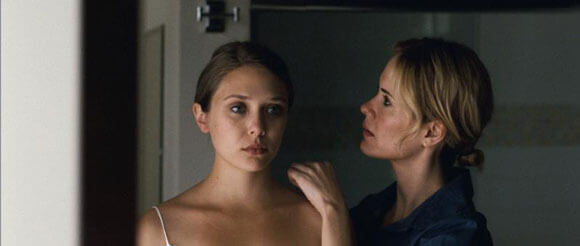
You’re a teacher and a leader. It’s just that no one has had the trust in you to say so. They don’t love you like I do.
Using words like that, am I any closer to recruiting you into my super awesome cult? No? I … understand.
Well, for Martha (Elizabeth Olsen), it’s a similar rap from Patrick (John Hawkes) that helps hook her into a makeshift family of young adults (think Charles Manson) in writer/director Sean Durkin’s Martha Marcy May Marlene. Patrick is the savior/provider of the group, and with it come the spoils – mostly in the form of laying with each of the ladies that have been assimilated into the cult. He knows all the tricks of the trade, even renaming everyone in the farmhouse/compound.
With Martha, that new moniker is Marcy May (the Marlene explanation comes much later). The film begins with her escaping from the cult and staying with her sister Lucy (Sarah Paulson) and brother-in-law, Ted (Hugh Dancy). The story flips back and forth between the present and the past in a number of very well-conceived and executed transitions that help blur the timeline. And rather than follow the traditional A-B-C story structure, we are merely given the basic structure of the cult through Martha’s eyes as she tries to bury those memories and readjust to the way society works outside of Patrick’s sphere of influence.
It’s all about the present and where Martha is at this very moment – with back-story filled in over the course of things to explain the haunted look in her eyes evident from the outset. If you’re one of those people who need a beginning, middle, and end, this is going to test you. It’s also not about getting a concrete resolution, there is ambiguity to how the story plays out, which is greatly appreciated by myself but not so much by others. Just be aware of your preferences.
However, if that isn’t a red flag, the rewards of seeing the film are great. Elizabeth Olsen delivers a tremendous performance, showcasing just about every emotion in the human repertoire. She’s fearless in her approach, baring her body and soul in order to convey the effect Patrick and his flock have had on Martha. She seems to have forgotten societal norms, having replaced them with whatever manner of action was deemed acceptable at the farmhouse. Just how far those changes have rewired her thinking is the elephant in the room.
That’s the beauty of Durkin’s film – the unpredictability. Audiences are only given bits and pieces of Martha’s life at Patrick’s farmhouse, dosed out measure by measure as the story unfolds. It’s never quite clear what the endgame will be or if the adage that ‘It’s not paranoia if they’re really out to get you’ applies in these circumstances. This kind of uncertainty takes a great deal of precision from everyone involved, from Durkin himself to editor Zachary Stuart-Pontier, to the entire production team, and to the actors.
To that end, the rest of the cast is also spot on. Paulson beautifully plays the role of big sister/de-facto mother. It’s easy to see why Martha disappeared from her life in the first place but also that the fracturing in their relationship was due to faults by both parties. Dancy delivers another surprisingly understated and yet effective turn (part of that due to my blind spot for remembering his real name until the credits rolled) as the brother-in-law trying to be supportive of his wife’s wish to take care of her family while also being wary of Martha’s bizarre behavior as an indicator of worse things to come.
And of course, in order to make the whole premise work, you need an outstanding performance from the cult leader, to which John Hawkes acquitted himself superbly. He mixes in the right balance of snake charmer, father figure, and tyrant to catch people in his web. It’s clear that Patrick has an innate sense of finding vulnerability in people and exploiting it for his own gain. This is made all the more intimidating because events like these have happened and are still happening. While not based directly on any one cult, Durkin managed to color everything with the right brush to allow audiences to watch Martha’s story unfold and, should anything be left off-screen or out of the final cut, to imagine the worst.
I haven’t been able to see Durkin’s 2010 short film, Mary Last Seen, which both helped him secure financing to make and served as a quasi-preface to, Martha Marcy May Marlene. Watching the trailer, it’s clear how it leads to where the long-form version begins, and Brady Corbet being in both helps create the literal connection. As such, it would have been nice to attach it to the theatrical release, much like the Edgerton brothers showed their short Spider before The Square (it even had a small, subtle tie into their feature); maybe it’ll be a nice extra on the DVD.
As for seeing this on the big screen, it’s not necessary, but I’m of the mind that any good film is better in a theater than at home (unless you’re a gazillionaire and have a ridiculous home theater … by the way, if that’s true, invite me over). It’s a harder sell because most audiences want to see plot progression, and might not be content with watching Martha at the beginning of her journey back to “normality.” However, for those who enjoy character studies and/or the effects and methodologies of cults, Martha Marcy May Marlene lands itself on a sadly short list of memorable films so far in 2011.
GRADE: A-
Martha May Marcy Marlene hit theaters in limited release on October 21, 2011 and is rated R for disturbing violent and sexual content, nudity and language.





